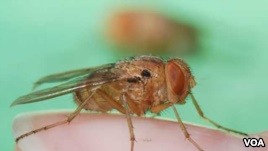From VOA Learning English, this is the Technology Report.
A fly with an extremely unusual ability to hear is the model for what may be the future of new and improved hearing aids. The insect behaves like a parasite -- an organism that lives on or in another organism called a host. This exceptional fly places larvae -- a young fly onto a cricket host. The larvae digs into the cricket and eats the insect from the inside out.
The tiny yellow fly lives in Central America and the southern United States. It finds its host by listening for the cricket's high chirping voice. The fly can easily find a cricket from as far away as 91 meters.

Ormia ochracea has an acute sense of hearing dedicated to pinpointing a cricket where it lays its larva. (Credit: Ronald Hoy Lab/Cornell University)
Neal Hall is a sound engineer who worked on the new hearing aid model. He says the fly's behavior is very strange. Mr. Hall and his team at the University of Texas made a copy of the fly's hearing structure.
"And they discovered that the fly has a clever mechanism that instead of using two independent ears, like a human would, the fly's ears are actually coupled," says Hall.
The fly's ears are two millimeters apart. That distance is so small, that sound reaches one ear just four millionths of a second before arriving at the other. Experts say it should be impossible to identify where a sound is coming from. But inside this fly's ear is a 1.5 millimeters long structure similar to a see-saw -- a piece of children's party equipment.
Like the see-saw, the fly's ear structure goes up and down from a central point. Pressure waves against the structure increase the time it takes for sound to travel and permit the fly to find its host.
Mr. Hall and his team used the chemical element silicon to copy the fly's ear structure. They also used special electric materials that enable them to measure its movements at the same time.
Hall says the hearing aid device could be used in two ways. One way would be to help the military on the battle field, there, sensors could find where shots are coming from. The second way would be to remove unwanted noise from a person's surroundings.
"That is a feature that is incredibly useful for hearing aids, for example, where right now, if you turn up the gain of a hearing aid or turn up the volume to hear someone across from you, it also amplifies everything else in the room," said Hall.
Hall says the next test in marketing the hearing aid device is to make it usable. He says the device must be handled carefully because it is so small. He notes that the fly does not have this concern.
And that's the VOA Learning English Technology Report. I'm Jonathan Evans.
文本来自51voa,译文属可可原创,仅供学习交流使用,未经许可请勿转载











